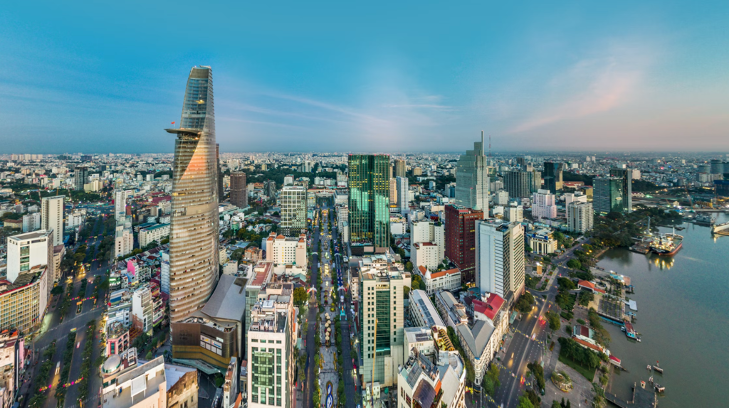Earlier this week, Export Connect was thrilled to deliver our first workshop as part of our Food & Fibre Gippsland Workshop Programme, in partnership with Regional Development Victoria and Investment Gippsland. This workshop looked at the opportunities available to food and beverage exporters, both new and experienced, in Vietnam, and covered everything from demographic factors to category-specific insights and e-commerce trends. For those unfamiliar with the Vietnamese market, it’s one of significant potential – with a young and growing population, rising household incomes and a rapidly growing middle class, it’s certainly a market to watch!
One of Asia’s Fastest-Growing Economies
Vietnam’s economy is one of impressive growth! Currently, GDP stands at US$271.2 billion and per capita, GDP is broken down to US$2,785. While these figures are relatively small compared to other Asian export markets such as South Korea and Japan, there is huge potential for growth! In fact, in the two years prior to COVID-19, Vietnam recorded consistent GDP growth of around 7% annually. Plus, a recent PWC report forecasts Vietnam to be one of the fastest growing global economies by 2050, with an annual GDP growth rate of 5.1%. This will support Vietnam’s growing GDP per capita, expected to reach US$19,200 by 2050.
When observing these figures, it’s no surprise that Vietnam ranks highly on the Market Potential Index, with a score of 15 out of 97 countries. Vietnam’s government should also be commended for its COVID-19 response, which saw low inflation and stable economic performance at 2.9% GDP growth in 2020, allowing Vietnam to rebound from the pandemic faster than its ASEAN peers. More recently, in 2022, Vietnam’s GDP growth has already proven promising, at 5.03% in the first quarter, supporting rising consumer confidence and an overall rise in consumer spending.
Strong Rankings on Various Trade Indexes
The Vietnamese economy is globally integrated, demonstrated through numerous free trade agreements including the ASEAN-Australia-New Zealand Free Trade Agreement, and the Comprehensive and Progressive Agreement for Trans-Pacific Partnership. These agreements have supported Vietnam’s position as one of Australia’s fastest-growing trade markets in the ASEAN region and provide preferential access for Australian exporters.
Vietnam’s economic freedom score also rests above the regional average at 61.7%, supporting a higher income for citizens. And, while the country’s Ease of Doing Business ranking is relatively conservative at 70th globally, this represents a dramatic improvement from 98th in 2010, illustrating that barriers to trade are consistently being broken down. Vietnam also benefits from a strong logistics network to facilitate the movement of goods, with a 2018 Logistics Performance Index score of 39 out of 160 countries.
A Young, Optimistic and Globally-Minded Consumer Base
Looking at the immediate situation post-COVID-19, Vietnam is arguably one of the best-placed economies in the Asia-Pacific. Relatively low COVID-19 infections have seen consumer sentiment hold strong and overall spending rise. In particular, grocery spending has remained stable throughout the pandemic, which is important to consider given Vietnamese consumers already allocate a staggering 42% of their monthly purchases to groceries. Alongside economic growth, rapid demographic changes are expected to occur in Vietnam in the longer-term. Vietnam’s middle class population is the fastest-growing in Asia, with forecasts predicting the country will reach upper-middle-income status by 2035. This is good news for Australian brands, especially considering Vietnam’s population already quadruples that of Australia at 97.34 million.
The Vietnamese consumer is increasingly open to Western imports, especially when it comes to food products, as rising concerns around food safety and quality spawn demand for premium foods. This reflects a wider trend where Vietnamese consumers look at product attributes like quality and brand over price. Demand for imports is also supported by Vietnam’s young population with a median age of 30.7 years, as younger consumers are more likely to engage with global food trends. These trends, coupled with a high willingness to try new products and brands, are all positive signs for Australian exporters! However, it’s not just quality products that consumers are after. They’re also seeking superior purchasing experiences–especially when shopping for groceries or dining out.
Ethics and Sustainability as Top of Mind Concerns
Interestingly, Vietnamese consumers are the most socially conscious in Asia, with a recent Nielson survey indicating that 86% of the population is willing to pay more for ethically-made products, whilst 79% exhibit a higher willingness to pay for functional and health food.
So, how are these influences impacting consumer spending? Well, shoppers are increasingly buying organic products, as well as goods with special health or wellness claims. And COVID-19 only accelerated this trend! Organic food does however remain a niche segment overall, with high prices limiting access to upper-middle and upper classes. Yet, as the middle class grows, the market represents strong potential, with products including organic baby milk powder, fruits and vegetables already recording strong sales.
Modern Grocery Retailers Gaining Traction Over Traditional Players
When we take a look at Vietnam’s food and beverage channels, it’s clear that traditional outlets like “tap hoa” grocers remain a preferred channel. However, this is slowly changing. As we’ve seen, consumers demand quality products. So, supermarkets are creating a competitive edge for themselves by offering higher quality products, many of which are imported. Their growth is also being supported by the government, which is providing supermarkets with the assistance they need to expand rapidly in both rural and urban areas.
Another trend that’s expected to remain, and grow, is the demand for convenient options. Vietnamese shoppers often frequent convenience stores because of their proximity to home. This has seen extraordinary growth for convenience stores like GS25 and 7-Eleven, which have more than quadrupled in the past decade. Supermarkets too are benefitting from convenience demands, with their diverse product lines and quality products accommodating busy consumer lifestyles. This convenience trend is also prompting major players to invest in more ready-to-eat meals and semi-cooked meals to stock their shelves.
Coupled with this trend, e-commerce will be a space to watch! Almost three-quarters of the population shops online at least twice a week, supported by a young and tech-savvy population. Jumping on consumer trend bandwagons, SMEs in the e-commerce space are focusing on vegetarian, vegan and organic products. Plus, strong competition has encouraged players to invest in logistics to differentiate themselves, further supporting e-commerce growth.
Consumer Trends Reflected In Growing and Contracting Categories
Now, let’s explore the categories with the greatest potential for food and beverage players in Vietnam. Consistent with other market’s we’ve dissected, alcoholic beverages outstrips growth of non-alcoholic ones at a 5-year CAGR to 2026 of 8.85% compared to -3.65%. Beer and cider is expected to perform especially well, with the CAGR to 2026 reaching an expected 9.81%, followed by spirits at 6.25%.
Looking at the food category, growth is expected to remain relatively consistent with a forecast 5-year CAGR of 4.70%. Categories to watch include bakery and cereal products, dairy and soy food, ice cream, meat substitutes, savoury snacks and seasonings, dressings and sauces–all of which are expected to see annual growth of over 6% across the next five years. Prepared meals will also see strong growth of up to 5.20%, reflecting the shift to more convenient meal solutions. Also reflecting wider social trends is the constricted growth of categories such as confectionery, meat, oils and fats, pasta and noodles, and soft drinks–which directly follows the shift towards healthier eating habits.
Challenges For Exporters in Entering the Market
Despite its huge potential for growth, challenges remain in the Vietnamese market. A low level of urbanisation, at 36.8% of the population, may present challenges for exporters in reaching large segments of Vietnam’s consumer base. This is largely due to the fact that traditional, rather than modern grocery retailers, dominate rural areas. While exporters should keep this in mind, it shouldn’t deter market entry, especially when considering Vietnam’s rapid pace of urbanisation and the increasing prominence of modern retailers.
For first-time exporters, entering the Vietnamese market isn’t always straight forward. A lengthy customs and quarantining process means that the compliance process before goods can even be shipped can be drawn out for weeks or even take months. Yet, once first-time exporters overcome this hurdle, exporting is far smoother sailing! Whilst we’ve also seen the demand for Western imports rise, local brand preference remains a common characteristic of Vietnamese consumers, and so exporting brands need to communicate their country-of-origin benefits to secure their place in consumer spending habits.
Wrap Up
That just about wraps up our look at Vietnam as an export market! While Vietnam certainly doesn’t present the same massive population as India or China, or the urbanisation rate of Singapore, several factors create a substantial opportunity for Australian exporters–from a rapidly growing economy and middle class, to rising population numbers and an open economy. Food and beverage exporters particularly will be pleased to see increasing demand for high-quality, Western food products, as well as the growth of modern grocery retailers and the sustainable and health food sectors. Meanwhile, Australian brands are encouraged by the growth of categories like beer and dairy food, which we’re known for!
We hope you’ve found these insights on the Vietnam market helpful. As always, if you’ve got any questions or want to discuss export opportunities for your company, feel free to drop us a line at Export Connect – we’d love to hear from you.



